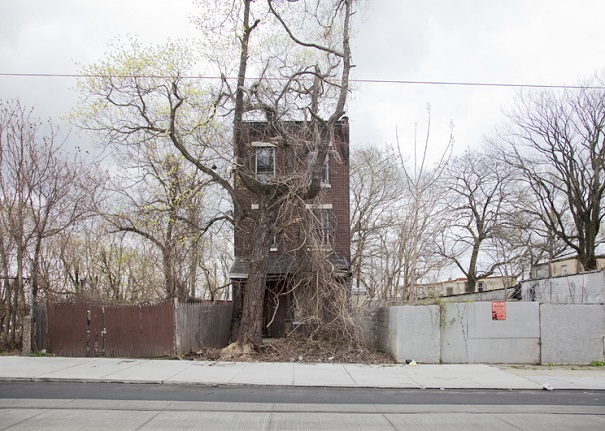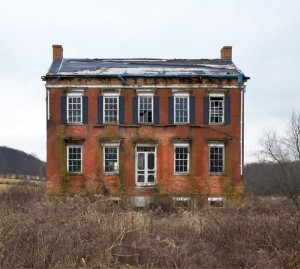Artist of the Week 11/6-11/12: A Photographer Apart: Ben Marcin Captures What Might Be the Last Documentation of Lone Structures across the North East
“It is like looking at an old person and just knowing that she was a beauty in her 20s or 30s,” photographer Ben Marcin explains about the abandoned homes in his two series Last House Standing and A House Apart. “You can just see the effects of the ravages of time and the things out of your control…but you can still see the twinkle.”
Interested in the changing demographics of some of America’s greatest cities in the Megalopolis area, the German native finds America’s gap between the upper and lower class mystifying. “It is a little unexpected, right? We are a great country, and we have all these resources, yet we also have a lot of poverty and a lot of disconnect between the rich and the poor,” Marcin expresses. His photographs depict abandoned homes, and he notes that, as industrial chains continue to spread in populated Megalopolis cities, entire neighborhoods have been deserted due to the vast increase of poverty that has since ravished them throughout the last hundred years. In another series, Camps, the photographer focuses on the homeless population of areas surrounding Baltimore and the way the camps are hidden among bustling industries. Influenced by nature, social movements and the passage of time, Marcin creates images that capture what he describes as the “ghostly beauty” of abandoned buildings.
A focus of Marcin’s photography is encapsulating what was once the hearth of a family but is now, in most cases, devoid of human life. Leaving people absent from his photography creates a focus on what used to be, in Marcin’s words, “a people’s space.” The photographer encourages his audience to imagine what types of people would have lived here. “You will never see people in my photographs, but they are always there,” Marcin explains. “I wanted my photographs to be like still lifes: very still, very quiet, kind of serene.” Seeing the buildings as a ghost of past families’ lives, Marcin attempts to give voice to an otherwise silenced part of American history. Being a row house homeowner himself, the structures’ appeal to Marcin does not stop at the bewilderment at the whereabouts of the previous homeowners, but also the physical manifestation of the buildings themselves.
The muses behind Marcin’s series Last House Standing are row houses erected in the 19th century, which used to be part of a structure that spread an entire block; however, as time has passed, only one house has been left standing. Homeowners, fleeing from the risk of being impoverished, oftentimes left their property without selling or endowing it to anyone. Many row houses were torn down by city government, and the run-down structures that do remain stick out like “pumpkin teeth,” Marcin attests. Capturing one structure per photograph, Marcin uses their distinctive presence to demonstrate the proliferation of poverty. Additionally, in some cities, such as Baltimore, impending plans were made by local government to demolish derelict homes on almost-vacant blocks. The immediacy of the demolition instills Marcin’s desire to document these buildings.
Marcin’s series A House Apart is an antithesis to Last House Standing. While his latter series demonstrates the collapse of an entire neighborhood, A House Apart represents the ruination of a single home that is set askew from the rest of society. With no neighbors in sight, his photographs capture images of the lives of people who once lived separated from any human activity but have since moved on. The overarching question remains the same: what happened to these people? As Marcin explains, “The jungle is sort of taking back from what [people] took from the jungle. The owner must have cleared the trees [before building a house] and now the trees are coming back.” These houses depict an existence without human maintenance and illustrate the dominant power of Mother Nature.
Marcin took a break from traveling, hiking, and photographing for his new series to speak to GALO about his photography and why he is passionate about photographing in America.

A photo taken of a building in Baltimore, MD for the “Last House Standing” series by Ben Marcin. Photo Courtesy of: Ben Marcin.
GALO: A theme that is present throughout your photography seems to be the importance of capturing individual subjects and memorializing them. Were you always interested in that theme throughout your life, or did you realize that interest through your art? Why did you choose to express this theme through capturing images of architecture rather than other cultural media?
Ben Marcin: I like solo things. I like things that stand apart by themselves. In the case of the A House Apart pictures, it is one house standing all by itself, for some reason. The row houses were attached to other ones, and everything else has been torn down except for one that is still standing there. These folks wanted to go out there on their own and get away from everybody else. I just like the fact that these structures and buildings are dead center by themselves, like “Leave me alone” [laughs]. Complete isolation. I deliberately avoided photographing people for a couple of reasons. [Firstly], there are really good people photographers out there! [Secondly], I was really trying to capture the isolation factor. You will never see people in my photographs, but they are always there. It’s kind of a negative space thing. You have to imagine, who lived in this house? Or, who would live in this house? I just wanted to approach it from the opposite way — this is a person’s space, but you don’t see them. You can only imagine what kind of life was being led here. I wanted my photographs to be like still lifes: very still, very quiet, kind of serene.

A photo taken of a building in Philadelphia, PA for the “Last House Standing” series by Ben Marcin. Photo Courtesy of: Ben Marcin.
GALO: All the buildings in the series Last House Standing seem to be photographed from the same distance and orientation. Looking through the images, each building is presented in the center of the frame. Was the symmetry of your photographs done to elicit a comparison between the buildings? Also, since centering the building in each image emphasizes its isolation, how would have altering the framing of each image changed its statement?
BM: No, it was more done as a typology. Once I decided these row houses were interesting, I wanted to kind of photograph them all the same way. It’s not a documentary; it’s really a contemporary photo essay. So every photo is taken from the same angle: dead straight on, the same space on the left and on the right, back and forth, top and bottom. Obviously, you will compare one to the next, but the thought was you will see the same thing over and over again, just variations of it. If I altered the framing of the images, you would have realized the structure is bigger than it appears to be. The way I photographed makes the buildings look very flat, so it masks the size of the building. A lot of these row houses were actually 60 to 80 feet long! All you see is the front; the windows are almost like eyes. Although I take away the depth, I show the left and the right side, so you can see the context of the situation. (These houses are obviously not in a nice neighborhood.) If I did it any other way, I felt it would have been distracting. It would have been a different photograph. This way, they all look the same, except it’s another building [laughs].
(Interview continued on next page)

